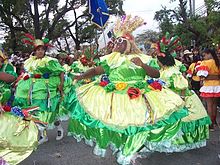- Dominican Carnival
-
Carnival in the Dominican Republic is celebrated during the whole month of February, although some towns celebrate it during March, Holy Week and August. It usually climaxes around February 27, Dominican Independence Day. This carnival is distinguished by its colorful costumes, that symbolize many religious and traditional characters such as Calife, Guloya or the famous Diablo Cojuelo. It is celebrated in most of the island, each town adding its own twist or creating their own characters and groups. It is enjoyed by young and old throughout the country since many of the groups are created by families, companies, and friends.
Contents
History
It is believed that this celebration was brought by Christopher Columbus when he came to America. The Christians would let their slaves have some diversion so that they got the "wild" out of their system, but also the slaveowners would enjoy this festivities. Since Christians considered this a "pagan" celebration they added their own inflections because they wanted to enjoy it.
Carnival has been celebrated in the Dominican Republic since the mid 1500's. Evidence of this has been found in the ruins of La Vega Vieja (near the present day La Vega) showing that celebrations were held here before they were celebrated in Santo Domingo. The celebration consisted that the resident dressed themselves as Moors and Christians.
It is thought that the colony of Santo Domingo was the first place in the Americas to show a pre-Lenten costume. The celebration became a way to escape from the rigid religious traditions. By the late 1700s the carnival became a major celebration in the colony. Then in February 27, 1844 when the Dominican Republic won its independence from Spain the celebration gained a bigger splendor, because the Dominicans were celebrating their independence. Making February a very festive month in the Dominican Republic. ,,,
Meaning
The celebration is showed as an "upside-down world", and since the country is Catholic by its constitution the rulers of the world must not be God or Jesus Christ but the Devil. Men dress as women, livestock dominates their ranchers is what you can expect in this eccentric carnival.The main character in the celebration is the "Diablo Cojuelo" (Limping Devil in English) this doesn't mean that it is a worship for the Devil, it is exactly the opposite because it is a satire of it.
Characters
The list of characters included during the celebration is immense, but there are some characters that are seen throughout the countries during the festivities. Such as:
- Diablo Cojuelo (Limping Devil): is the main character during the carnival. Most of the towns and cities in the country have their own version of it, but it has some country-wide characteristics such as the use of a mask, showy suits of satin, sleighbells, a "Vejiga" which is an animal bladder filled with air which is used to hit people in the streets or a Whip (to hit other "Diablos").
- Roba la Gallina (Steal the Chicken): is a satire of a way that some people used to steal chickens from farms, that consists of a man dressing up with a dress and then using the chickens as their cleavage and hips, in the carnival the chickens are substituted with pillows or sacks.
- Califé: is a character that shouts poetry during the festivities making complaints about situations, government officials, portraying the people's voice.
- Se me muere Rebeca (Rebeca is dying): is woman that portrays another woman from a low social class that has an ill daughter(Rebeca) and can't pay the medicines, and goes out to the street to shout about it, acting likes she's phsycotic about this.
There are many more but those are some of the most used around the country, it is important to say that every town has their own variations of these and some original characters.
Celebration
There are many ways in which it is celebrated, but most towns and cities share common characteristics:
- They are held mostly in the main streets of the town or city.
- People gather in the street and curb to watch the parade.
- Most of the disguised people carry a "Vejiga" to hit people. This is done in most towns.
- Music is played through all the celebration adding some excitement to it.
Main Parades
There are some Dominican cities that hold world-renowned parades such as:
- La Vega: Holds one of the biggest parades in the Dominican Republic with more than 20 different groups, each one with a different costume. This parade attracts people from all over the country and also tourists from around the world.
- Santo Domingo: Being the biggest city in the Dominican Republic it holds the biggest parade in the country by gathering all of the different groups and characters from al over the country in the National Parade.
- Montecristi: It is a very peculiar parade, showing two groups "Los Toro", dressed with costumes and a pig mask, and "Los Civiles" dressed with casual clothes. This two groups, both of them carrying whips literally fight with them in the main streets of the town. This is not the biggest in the country but its peculiarity is starting to attract people to it.
Categories:- Carnivals
- Events in the Dominican Republic
Wikimedia Foundation. 2010.


